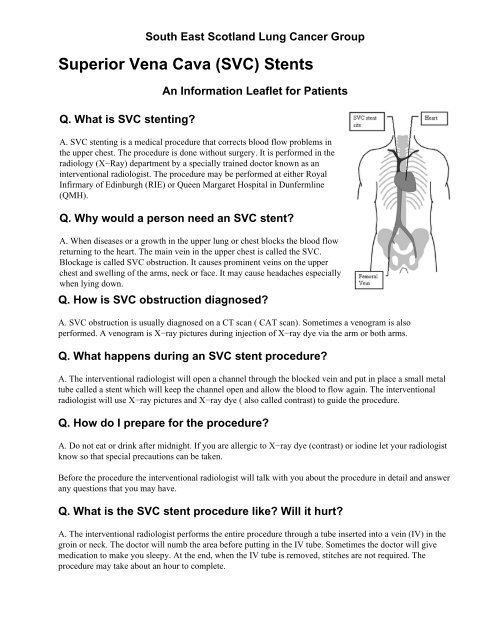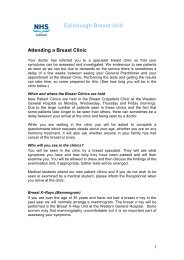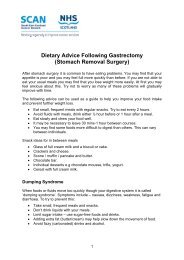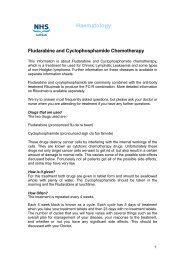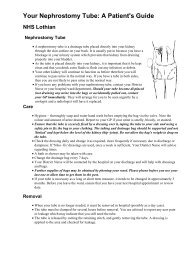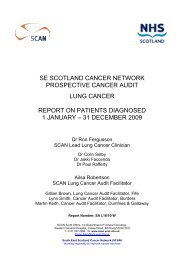Superior Vena Cava (SVC) Stents - SCAN
Superior Vena Cava (SVC) Stents - SCAN
Superior Vena Cava (SVC) Stents - SCAN
You also want an ePaper? Increase the reach of your titles
YUMPU automatically turns print PDFs into web optimized ePapers that Google loves.
South East Scotland Lung Cancer Group<br />
<strong>Superior</strong> <strong>Vena</strong> <strong>Cava</strong> (<strong>SVC</strong>) <strong>Stents</strong><br />
Q. What is <strong>SVC</strong> stenting?<br />
An Information Leaflet for Patients<br />
A. <strong>SVC</strong> stenting is a medical procedure that corrects blood flow problems in<br />
the upper chest. The procedure is done without surgery. It is performed in the<br />
radiology (X−Ray) department by a specially trained doctor known as an<br />
interventional radiologist. The procedure may be performed at either Royal<br />
Infirmary of Edinburgh (RIE) or Queen Margaret Hospital in Dunfermline<br />
(QMH).<br />
Q. Why would a person need an <strong>SVC</strong> stent?<br />
A. When diseases or a growth in the upper lung or chest blocks the blood flow<br />
returning to the heart. The main vein in the upper chest is called the <strong>SVC</strong>.<br />
Blockage is called <strong>SVC</strong> obstruction. It causes prominent veins on the upper<br />
chest and swelling of the arms, neck or face. It may cause headaches especially<br />
when lying down.<br />
Q. How is <strong>SVC</strong> obstruction diagnosed?<br />
A. <strong>SVC</strong> obstruction is usually diagnosed on a CT scan ( CAT scan). Sometimes a venogram is also<br />
performed. A venogram is X−ray pictures during injection of X−ray dye via the arm or both arms.<br />
Q. What happens during an <strong>SVC</strong> stent procedure?<br />
A. The interventional radiologist will open a channel through the blocked vein and put in place a small metal<br />
tube called a stent which will keep the channel open and allow the blood to flow again. The interventional<br />
radiologist will use X−ray pictures and X−ray dye ( also called contrast) to guide the procedure.<br />
Q. How do I prepare for the procedure?<br />
A. Do not eat or drink after midnight. If you are allergic to X−ray dye (contrast) or iodine let your radiologist<br />
know so that special precautions can be taken.<br />
Before the procedure the interventional radiologist will talk with you about the procedure in detail and answer<br />
any questions that you may have.<br />
Q. What is the <strong>SVC</strong> stent procedure like? Will it hurt?<br />
A. The interventional radiologist performs the entire procedure through a tube inserted into a vein (IV) in the<br />
groin or neck. The doctor will numb the area before putting in the IV tube. Sometimes the doctor will give<br />
medication to make you sleepy. At the end, when the IV tube is removed, stitches are not required. The<br />
procedure may take about an hour to complete.
Q. What happens after my <strong>SVC</strong> stent procedure?<br />
A. You will return from the radiology department to your ward bed. If your ward was at a different hospital<br />
you will remain at the RIE or QMH for a period of observation (usually an hour or two). Sometimes it may be<br />
more practical to stay overnight. The doctors or nurses will tell you when you can eat and how long you have<br />
to stay in bed.<br />
There may be swelling or bruising in the groin or neck where the IV tube was placed. This will go away in a<br />
few days to a week and generally requires no treatment.<br />
Q. How quickly does the <strong>SVC</strong> stent work?<br />
A. If you have swelling of the face and neck this should get better in a few days. Arm swelling may take<br />
longer to get better. Some symptoms like headache may go away immediately.<br />
Q. What are the risks of the <strong>SVC</strong> stent procedure?<br />
A. Any procedure involving blood vessels has a risk of bleeding. The risk of serious bleeding occurs is about<br />
1%. Occasionally the stent can block later causing the symptoms to return. Usually this is treated by inserting<br />
another <strong>SVC</strong> stent.<br />
Q. Are there alternatives to <strong>SVC</strong> stenting?<br />
A. The blockage of the blood vessels in the upper chest is sometimes best treated with an <strong>SVC</strong> stent and<br />
sometimes best treated with radiotherapy or chemotherapy. (Radiotherapy is treatment with x−rays and<br />
chemotherapy is treatment with drugs.)<br />
Q. What are the benefits of <strong>SVC</strong> stenting?<br />
A. Your symptoms may improve more quickly than with other treatments and <strong>SVC</strong> stenting has fewer side<br />
effects than radiotherapy and chemotherapy. However your doctor may recommend further treatment with<br />
radiotherapy or chemotherapy in order to treat the growth once the blockage has been relieved by the stent.


